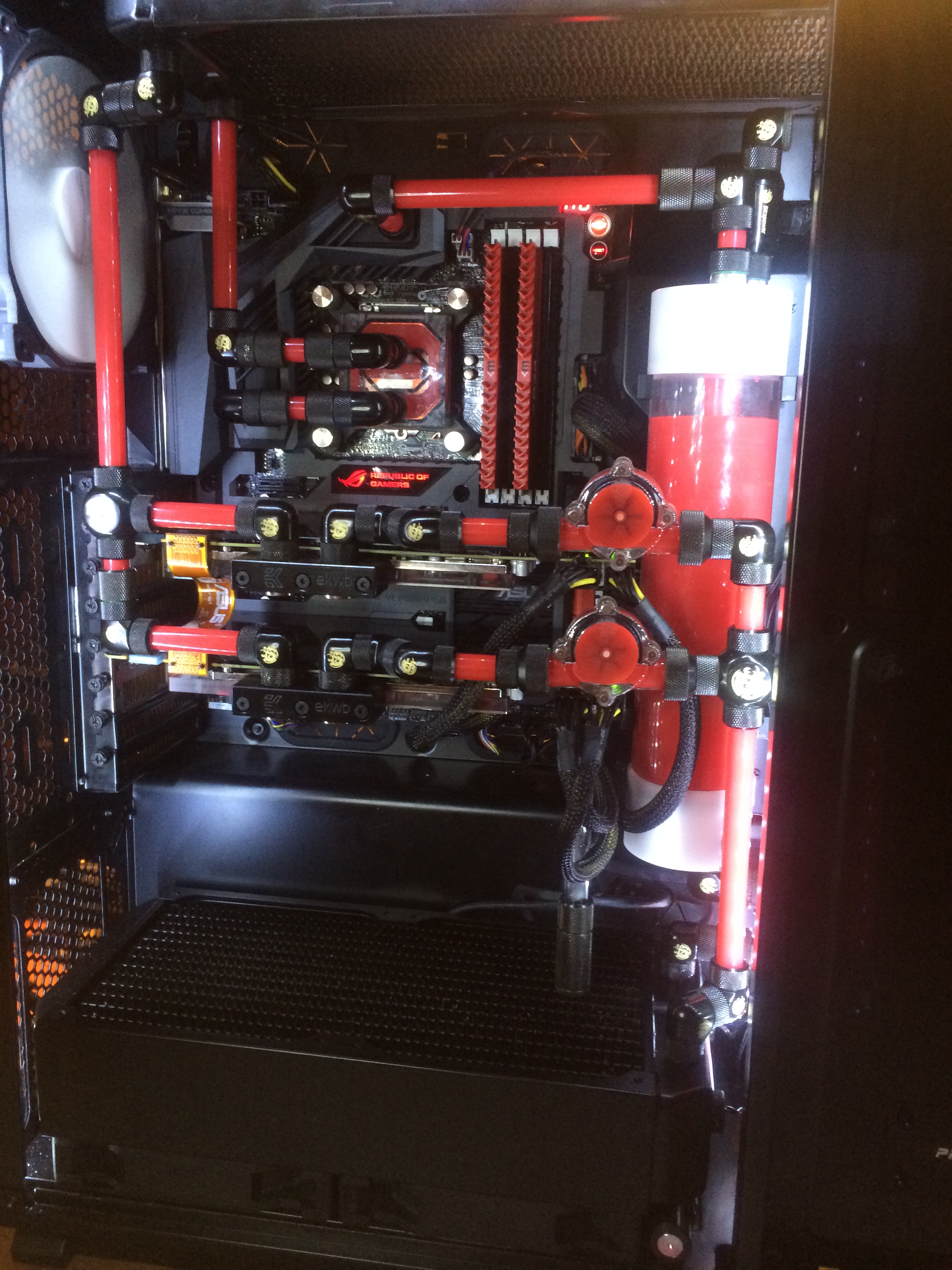Niels:
Nicely done...... most 1st time builders go down quite a bit more blind alleys on their first build. Some tips for the next time you tackle this
1. Put TIM on the GPU memory / VRM.
https://shop.ekwb.com/EK-IM/EK-IM-3831109868614.pdf
Step 3 - PLACING THERMAL PADS ON PCB.
Place thermal pads on chips so that numbers on chips match size of thermal pads. You may use small drops of electrically non-conductive (for example: EK-TIM Ectotherm, Arctic Cooling MX-2™ or GELID GC-Extreme™) thermal grease on each phase regulator (that is being covered with thermal pad) in order to even further improve the thermal performance of the EK-FC780 GTX Ti series water block.
GELID TIM is actually ideal for GPUs as it remains pliable and you can apply it w/ the lil spatula thing they give you. It remains "spreadable" longer than most other TIMs, but does tend to get thick by the time you spread on the 18 pads (top and bottom).
Try it next time with the Enthoo Pro / Luxe which comes with built in radiator friendly fan controller and built in pump / reservoir mounts. You can see the difference in room and cable routing here:
https://www.youtube.com/watch?v=GdWXLAmmSjc
A 420 easily fits on top.
3. You don't mention what fans you are using or if you did I missed it. But that really is not overkill and certainly "sensible"
60mm thick 360 is good for about 180 watts @ 1250 rpm and the 35 mm 240 is good for about 120 more for a total of 300 watts @ 10C delta T. You didn't fit the 140 but it would have added little.
An overclocked 4690k and hit 135 and the 780 Ti can hit 300 and finally add 20 watts for the pump..... you'll want at least 60% of that or 273 watts handled by the rads (455 x 0.6). I'd expect a Delta T of about 9C and you';; have no problem keeping fan rpms well below the 850rpm point where they become audible.
A good rule of them if looking for a quite build is 120mm of rad for each 100 watts of load. At 455 watts, 4.55 120mm lengths of Rad would net you the general design target of 10C. Of course, many do with less and use higher rpm fans which is certainly doable if you don't mind the noise. Otherwise, it's just a matter of how high a delta T you are willing to live with.
I'd have recommended fittings for your 1st acrylic tube. Takes about as long but if you err on the side of "conservative" when cutting, you can always go back and "take a lil more off"
Bending should not be attempted with a good "bending kit" . The mandrels and silicon insert tubes especially make things a lot easier
http://www.frozencpu.com/products/22334/too-129/Monsoon_Hardline_Pro_Full_Bending_Kit_-_38_x_12_13mm.html
(Yes, I know FCPU is "down for the count" but they still have the easiest, most searchable web site)
4. One thing I would suggest is vibration isolation for the pump. Most pump noise comes from the pump transmitting vibrations to the tubing, case and other components. Some cases Phanteks) provide mounts for vibration isolation for this purpose but are available separately. You can't see it in the acrylic build above but the twin pumps are on a vibration isolated mount with a vibration isolated heat sink stand with a thermal / vibration pad between the sink and pump. To isolate the pump from the rigid tubing, two 3" lengths of flexible tubing are used.
5. Bleed tip. Bleeding from the highest point in the loop makes things easier. Radiators which provide both top and bottom ports come in handy here.
6. A quick disconnect drain line can be handy. Most over estimate the need for "maintenance"... with an engineered coolant, you needen't do anythkng for 2 years or so.... (I do 18 months but more so just to get a fresh color in there)
7. Loved your comments about what you learned and how you'd change things. There are various steps you can take to help you along.
-Measure up the case before deciding whether to buy
-Make mockups of GFX cards and other devices if you don't have them yet. Check out my 780 Ti mockup. I could sent it to ya for you to test fit

.... as it turned out it did in mine .... by 2mm.
-Measure twice, cut once advice should double the measuring part
-Look at product dimensions .... some rads will fit in places that other's don't. One 140mm rad might be 143mm wide another might be 146 .... matters when case allows for 145.
-Include a drain port w/ quick disconnect.
-Use fan PCB for radiator fan control.
-When doing SLI / CF, split the streams before the cards and recombine after. Cuts back pressure by factor of 4
Again, well done .... i think peeps learn more from articles like this which include the mis-steps as well as the final result.


 .... as it turned out it did in mine .... by 2mm.
.... as it turned out it did in mine .... by 2mm.